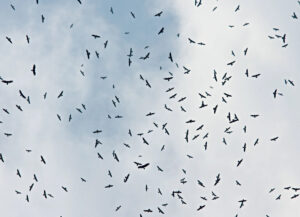Third International Scientific and Practical Conference “Eagles of the Palearctic: Study and Conservation”
Raptors Conservation. Suppl. 2. Proceedings of Conferences
CMS Raptors MOU: New Opportunities for Raptors Conservation in Africa and Eurasia Emerging from the Third Meeting of Signatories
Gallo-Orsi U., Lopes L. (Raptors MoU Coordinating Unit at Convention on Migratory Species, Abu Dhabi, UAE)
Contact:
Umberto Gallo-Orsi umberto.galloorsi@un.org
Lauren Lopes lauren.lloydlopes@un.org
Recommended citation: Gallo-Orsi U., Lopes L. CMS Raptors MOU: New Opportunities for Raptors Conservation in Africa and Eurasia Emerging from the Third Meeting of Signatories. – Raptors Conservation. 2023. S2: 181–185. DOI: 10.19074/1814-8654-2023-2-181-185 URL: http://rrrcn.ru/en/archives/35006
The Convention on Migratory Species’ Memorandum of Understanding on the Conservation of Migratory Birds of Prey in Africa and Eurasia (Raptors MOU) represents a unique international agreement dedicated to the preservation of migratory raptors belonging to the orders Accipitriformes, Falconiformes, and Strigiformes.
At the Third Meeting of Signatories to the Raptors MOU (MOS3), held in Dubai from 3 to 6 July 2023, significant progress was made towards advancing commitments for the conservation of these majestic birds. The primary outcomes of MOS3 are summarized below.
Revised MOU mandate:
An evaluation of the MOU’s implementation conducted in 2020 underscored the need to better align and enhance the clarity of the commitments contained in the MOU’s Text and in its Annexes (one of which being the MOU’s Action Plan). Consequently, several amendments to these documents were made. Notably, the Activities of the MOU’s Action Plan were comprehensively rewritten, with each now being accompanied by clear targets and means of verification.
Updated list of species:
The MOU now encompasses 94 distinct species of migratory bird of prey. Notably, the Yellow-billed Kite (Milvus aegyptius) is now recognized as a separate entity from the Black Kite (M. migrans). In addition, the MOU’s revision includes the new order Accipitriformes.
Revised species categorization:
Species listed under the Raptors MOU are categorized into one of three categories based on their extinction risk. At MOS3, individual species’ categories were updated according to the latest IUCN Red List assessment. The update resulted in an increased number of species classified under Category 1 (globally threatened or Near Threatened species) and Category 2 (species considered to have an unfavourable conservation status at a regional level), reflecting a deteriorating conservation status for 13 species. Conversely, only three species saw their conservation status improve and move to a lower category.
Expanded list of internationally important sites for raptors:
The MOU previously included a "Provisional list of Important Bird Areas that are known to be significant congregatory sites for birds of prey in Africa and Eurasia”. Now named "List of Internationally Important Sites for Migratory Birds of Prey", the list has been broadened to incorporate sites listed as Important Bird Areas due to their importance for at least one species listed in Annex 1 of the MOU or because are "bottleneck" locations for migrating raptors. Additionally, those sites proposed by Signatories as meeting the same criteria have been included. Furthermore, for States current and former Members of the European Union the list includes sites designated as Special Protection Areas under the European Council’s Birds Directive. This network of important sites now represents the most extensive collective effort for raptor conservation in Africa and Eurasia, with the potential to significantly contribute to their preservation.
Renewed membership of the Technical Advisory Group to the Raptors MOU (TAG):
The purpose of the TAG is to serve and assist Signatories in the effective implementation of the Raptors MOU. A renewed TAG membership was elected at MOS3, increasing the number of serving women from one to four.
First Raptor Conservation Status Assessment Report:
Under the coordination of BirdLife International, the TAG has produced an assessment report of the conservation status of the raptor species covered by the MOU. This report paints a disconcerting picture of the rapidly declining conservation status of the 94 listed species, with 54% presenting declining global populations and 34% now facing elevated extinction risk. The most threatened group are Vultures (93% of spp. included in Category 1), followed by Eagles (50%) and Falcons (26%). The rate of extinction of migratory raptor listed in the MOU is outpacing that of all birds and even all raptors in general. The report emphasizes that the principal threats to these birds are habitat loss and degradation, illegal killing and taking, and electrocution and collision with energy infrastructure. Notably, the impact of electrocution and collision may be underestimated, as one-third of satellite-tagged raptors (excluding vultures) fall victim to these hazards.
In light of these alarming findings, it is evident that a coordinated, collaborative effort involving researchers, conservationists, governments and other stakeholders is imperative to mitigate the decline of migratory raptors. The Raptors MOU stands as a crucial technical framework that can facilitate and guide these essential conservation endeavors. The development of International Single Species Action Plans for Black Harrier (Circus maurus), Steppe Eagle (Aquila nipalensis), Beaudouin’s Snake Eagle (Circaetus beaudouini), Pallas’s Fish Eagle (Haliaeetus leucoryphus), Steller’s Sea Eagle (H. pelagicus) and Tawny Eagle (A. rapax) is considered a priority.

